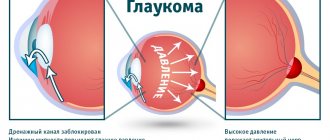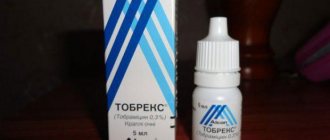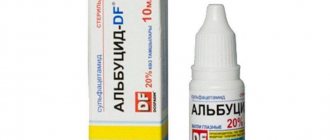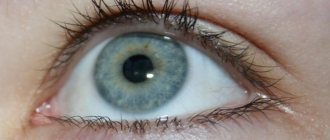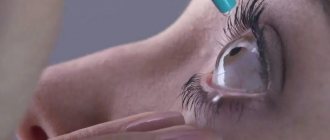"Xalatan" is a medicinal pharmaceutical product. These are eye drops to lower intraocular pressure. It is sold in this form in pharmacies. The drug is very popular on the Russian market.
The drug is prescribed by the attending ophthalmologist to people with increased intraocular pressure, primary and secondary open-angle and pseudoexfoliative forms of glaucoma.
This is one of the most effective medications for improving fluid outflow and reducing pressure. The drug is quite expensive. Cheap analogues of Xalatan are available for sale.
Compound
- The main ingredient is latanoprost 0.05 mg.
- Additional substances: sodium chloride - 4.1 mg, sodium dihydrogen phosphate (monohydrate) - 4.6 mg, sodium hydrogen phosphate (anhydrous) - 4.74 mg, benzalkonium chloride - 0.2 mg, water for injection - 995 mg.
- Eye drops 0.005% are sold in sterile instillation bottles of 2.5 ml with first opening control. Packed in cardboard boxes of one or three pieces.
Travatan's analogs
Analogues of Travatan can be divided into 2 groups:
- Generics based on travoprost.
- Preparations with similar effects, but with a different active substance.
With the same active ingredient
Drugs from the first group will be useful if the Travatan prescribed by your doctor is not available in the nearest pharmacy or you don’t want to spend money on a well-promoted brand. As a rule, imported and Russian generics are cheaper than the original medicine, but are not inferior in quality.
| Name | Price, rub. | Note |
| Travapress | From 498 | This is a complete, but cheaper analogue of Travatan. The content of the active substance is 0.040 mg per 1 ml of drops, and the list of auxiliary components is similar. Produced by the Romanian corporation ROMFARM COMPANY, packaged in polymer dropper bottles of 2.5 ml |
| Glautan | From 450 | The drug is produced by the Ukrainian pharmaceutical company FARMAK. Dosage, purpose and possible side effects are completely identical |
| Daveris | From 524 | Another antiglaucoma drug based on travoprost. Manufacturer – ROMFARM COMPANY (Romania) |
| Travoprost | – | A generic product made in India, which is occasionally sold in pharmacies in Russia and the CIS countries |
| DuoHerbs | From 823 | A combined antiglaucoma drug containing travoprost and timolol. Produced by ALCON. It has a wider list of contraindications, which include corneal dystrophy, bronchial asthma, COPD, severe heart failure and severe allergic rhinitis |
Like Travatan, all generics can cause irreversible changes in iris color . This side effect does not affect the condition and functioning of the organ of vision and may even go unnoticed for several months. Typically, a change in eye color is noted by patients with mixed iris color, when there is a combination of brown pigment with green, blue, gray or yellow.
pharmachologic effect
The active substance latanoprost is a substitute for natural prostaglandin F2a, which has a selective effect on eye receptors. A decrease in ophthalmonus is observed several hours after using the drug and reaches its greatest effect after twelve hours.
The antiglaucoma effect occurs due to the large outflow of fluid from the chambers of the eye. The drug does not affect the formation of intraocular fluid and vascular permeability. After use, the product takes effect within 24 hours.
Xalatan
Use during pregnancy and breastfeeding
There have been no adequate controlled studies in pregnant women.
The drug should be prescribed during pregnancy only in cases where the expected benefit to the mother outweighs the possible risk to the fetus. Latanoprost and its metabolites can be excreted in breast milk, so the drug should be used with caution during breastfeeding.
Use in children
Contraindicated for use in children under 1 year of age.
special instructions
Xalatan® should be prescribed no more than 1 time/day, because more frequent use of latanoprost leads to a weakening of the IOP-lowering effect.
If one dose is missed, the next dose should be administered at the usual time.
Latanoprost can be used concomitantly with other classes of topical ophthalmic medications to lower IOP. If the patient is using other eye drops at the same time, they should be used at least 5 minutes apart.
Xalatan® contains benzalkonium chloride, which can be absorbed by contact lenses. Before instilling drops, contact lenses must be removed and reinserted after 15 minutes.
Latanoprost may cause a gradual increase in brown pigment in the iris. The change in eye color is caused by an increase in the melanin content in the stromal melanocytes of the iris, and not by an increase in the number of melanocytes themselves. In typical cases, brown pigmentation appears around the pupil and extends concentrically to the periphery of the iris. In this case, the entire iris or parts of it become brown. In most cases, the color change is minor and may not be clinically detectable. Increased pigmentation of the iris of one or both eyes is observed mainly in patients with mixed iris color, containing a brown color as a base. The drug has no effect on nevi and lentigines of the iris; no accumulation of pigment in the trabecular meshwork or in the anterior chamber of the eye was noted.
When determining the degree of pigmentation of the iris for more than 5 years, no undesirable consequences of increased pigmentation were revealed, even with continued therapy with latanoprost. In patients, the degree of IOP reduction was the same, regardless of the presence or absence of increased iris pigmentation. Therefore, treatment with latanoprost can be continued in cases of increased pigmentation of the iris. Such patients should be monitored regularly and treatment may be discontinued depending on the clinical situation.
Increased pigmentation of the iris is usually observed during the first year after the start of treatment, rarely during the second or third year. After the fourth year of treatment, this effect is not observed. The rate of pigmentation progression decreases over time and stabilizes after 5 years. In the longer term, the effects of increased iris pigmentation have not been studied. After stopping treatment, no increase in brown pigmentation of the iris was noted, but the change in eye color may be irreversible.
In connection with the use of latanoprost, cases of darkening of the skin of the eyelids have been described, which may be reversible.
Latanoprost may cause gradual changes in eyelashes and vellus hairs, such as lengthening, thickening, increased pigmentation, increased thickness, and a change in the direction of eyelash growth. Changes in eyelashes are reversible and disappear after cessation of treatment.
Patients using drops in only one eye may develop heterochromia.
Impact on the ability to drive vehicles and operate machinery
The use of eye drops may cause transient blurred vision. Driving a car or using complex machinery while using the drug should be done with caution.
Side effects and overdose
The drug "Xalatan" (including analogues) has the following side effects:
- Local reaction: mild irritation, redness and inflammation of the mucous membrane of the eye may occur. This side effect is observed in 10% of people, only 1% have an average severity. There may be pain, increased lacrimation, dryness, photophobia, decreased visual acuity, changes in pupil color, changes in eyelash growth, and swelling of the center of the retina.
- Respiratory system: difficulty breathing, narrowing of the lumen of the bronchi due to muscle contraction (bronchospasm).
- Nervous system: sensation of pain in the head or fainting state (usually dizziness).
- Musculoskeletal system: pain in joints and muscles.
- Skin: discoloration (blackening) of the eyelids, skin rashes, Lyell's syndrome (the appearance of blisters and erosions on the skin and mucous membranes).
- Infestations and infections: inflammation of the cornea caused by one or more types of herpes virus (herpetic keratitis).
- Other side effects: pain in the chest of a nonspecific nature.
- People who have diabetes with damage to the retina (diabetic retinopathy) may have a blockage, peeling of the membrane, or bleeding in the vitreous area while using this drug.
- In childhood, there is an increase in body temperature and inflammation of the mucous membrane of the nasopharynx.
- In patients with obvious damage to the cornea, calcification is possible in exceptional cases.
- If the drug is accidentally ingested, dizziness, pain in the gastrointestinal tract and nausea may occur. Treatment is symptomatic. It is necessary to rinse the stomach.
These are the side effects that Xalatan (eye drops) can have. Analogues have side effects to no lesser extent.
Travatan
To decide on analogues of Travatan, you first need to understand what the original drug is. It is a transparent liquid without color or with a barely visible yellowish tint. The drug is packaged in polymer dropper bottles with a volume of 2.5 ml. Each bottle is sealed in an aluminum foil bag and packed in a cardboard box.
The main active ingredient of Travatan is travoprost, a synthetic substitute for prostaglandin F2α. This substance belongs to the group of lipids and is formed in the body as a result of complex chemical processes. Prostaglandins help restore the altered balance between the production and elimination of aqueous humor. As a result, intraocular pressure approaches normal levels.
After travatan drops are instilled into the eyes, the active substance penetrates the cornea, where it transforms into a biologically active form and begins to act within 1-2 hours. The therapeutic effect reaches its maximum 12 hours after instillation.
Travatan can be stored sealed for 3 years from the date of release, but after opening the bottle, the shelf life is reduced to 28 days. Therefore, patients with glaucoma need to buy a new package of the drug every month and discard the bottle of unused liquid.
Indications and contraindications
Travatan is intended to reduce intraocular pressure, which occurs when:
- open angle glaucoma,
- increased ophthalmotonus.
These eye drops are only suitable for use by persons over 18 years of age. Contraindications include individual intolerance to travoprost or one of the auxiliary components.
The instructions for use indicate that Travatan drops should be prescribed with caution to patients who are at high risk of developing macular edema. It is not recommended to use the medicine for uveitis and acute iritis.
Travatan is prohibited for use by pregnant and lactating women! In special cases, when the benefit to the mother's health outweighs the risk of developing pathologies in the child, the doctor may prescribe travoprost drops during breastfeeding.
Directions for use and side effects
The medicine should be used only once a day, preferably in the evening. Standard dosage: 1 drop in each eye. Increasing the dosage or frequency of use may reduce the effectiveness of the drug.
If the patient is prescribed several eye drops of different effects, the break between instillations should be 15-30 minutes. Patients with contact lenses (decorative or for vision correction) should remove them before administering the drug and put them on no earlier than 15 minutes after instillation.
The use of Travatan may cause local side effects:
- redness of the conjunctiva,
- blurred vision,
- sensation of a foreign object, pain and burning in the eyes,
- fog before the eyes,
- dry conjunctiva,
- blepharitis,
- keratitis,
- increased lacrimation,
- change in iris color,
- increased sensitivity of the eyes to bright light.
Systemic side effects include:
- headache,
- depression,
- causeless anxiety
- back and joint pain,
- blood pressure surges,
- angina pectoris
- bradycardia,
- chest pain,
- infections of the urinary system,
- urinary incontinence,
- indigestion,
- bronchitis,
- sinusitis.
Blurred vision, redness of the eyes and other unpleasant symptoms usually disappear within a few minutes after administration of Travatan. In other cases, it is necessary to consult a doctor to correct the eye treatment regimen and prescribe another antiglaucoma drug.
Precautionary measures
Doctors do not recommend increasing the dose of the drug. This leads to a decrease in the effect of lowering intracranial pressure. May be used with other ophthalmic medications to reduce intraocular pressure.
If you miss a single instillation of the drug, then instill only one drop at the same time the next day to avoid unnecessary negative effects.
When using two types of medicines, the time interval between the administration of drops should be 5-10 minutes. But it’s better not to mix the drops, use them alone.
It is necessary to remove contact lenses before instillation, otherwise benzalkonium chloride will be absorbed. Reinstalling the lenses is possible after 20 minutes.
Treatment should be continued if the color of the iris changes, but under the supervision of an ophthalmologist. The prescription of Xalatan can be canceled, but, as a rule, increased pigmentation is not accompanied by pathological changes.
When prescribing treatment in one eye, there is a possibility of developing unequal coloration of the iris of the left and right eyes (heterochromia).
"Xalatan" (analogs as well) is prescribed with caution to people driving vehicles and complex equipment, since there is a possibility of a quickly passing feeling of a veil before the eyes. It is better to install the drug outside of a hazardous activity. There is a possibility of temporary darkening of the eyelids.
The product may cause changes in the growth, color of eyelashes and vellus hair. After discontinuation of the drug, the effect goes away on its own. During pregnancy and lactation, Xalatan (analogs as well) is prescribed with caution.
During use, do not touch the bottle to your eyes or various objects. It is prescribed with great caution for congenital or acquired absence of the lens (aphakia) and inflammation of the choroid (uveitis).
Concomitant use with drops containing thiomersal is not recommended. Strengthening the effect of Xalatan while taking pilocarpine and timolol.
Xalatan, 3 pcs., 2.5 ml, 0.005%, eye drops
Xalatan® should be used no more than once a day, since more frequent administration of latanoprost leads to a weakening of the IOP-lowering effect.
If one dose is missed, the next dose should be administered at the usual time.
Latanoprost can be used concomitantly with other classes of topical ophthalmic medications to lower IOP. If the patient is using other eye drops at the same time, they should be used at least 5 minutes apart.
Xalatan® contains benzalkonium chloride, which can be absorbed by contact lenses. Before instilling drops, contact lenses must be removed and reinserted after 15 minutes.
Latanoprost may cause a gradual increase in brown pigment in the iris. The change in eye color is caused by an increase in the melanin content in the stromal melanocytes of the iris, and not by an increase in the number of melanocytes themselves. In typical cases, brown pigmentation appears around the pupil and extends concentrically to the periphery of the iris. In this case, the entire iris or parts of it become brown. In most cases, the color change is minor and may not be clinically detectable. Increased pigmentation of the iris of one or both eyes is observed mainly in patients with mixed iris color, containing a brown color as a base. The drug has no effect on nevi and lentigines of the iris; no accumulation of pigment in the trabecular meshwork or in the anterior chamber of the eye was noted.
When determining the degree of pigmentation of the iris for more than 5 years, no undesirable consequences of increased pigmentation were revealed, even with continued therapy with latanoprost. In patients, the degree of IOP reduction was the same, regardless of the presence or absence of increased iris pigmentation. Therefore, treatment with latanoprost can be continued in cases of increased pigmentation of the iris. Such patients should be monitored regularly and, depending on the clinical situation, treatment may be discontinued.
Increased pigmentation of the iris is usually observed during the first year after the start of treatment, rarely during the second or third year. After the fourth year of treatment, this effect was not observed. The rate of pigmentation progression decreases over time and stabilizes after 5 years. In the longer term, the effects of increased iris pigmentation have not been studied. After stopping treatment, no increase in brown pigmentation of the iris was noted, but the change in eye color may be irreversible.
In connection with the use of latanoprost, cases of darkening of the skin of the eyelids have been described, which may be reversible.
Latanoprost may cause gradual changes in eyelashes and vellus hairs, such as lengthening, thickening, increased pigmentation, increased thickness, and a change in the direction of eyelash growth. Changes in eyelashes are reversible and disappear after cessation of treatment.
Patients using drops in only one eye may develop heterochromia.
The use of eye drops may cause transient blurred vision.
Impact on the ability to drive a car and operate machinery.
Caution should be exercised when using the drug.
Xalatan drops: analogues
Substitutes for "Xalatan" are used when it is not available in the pharmacy, when getting used to this drug, if side symptoms are identified:
- "Cosopt" (Netherlands) - 800-900 rubles.
- "Trusopt" (France, USA) - 450-470 rubles.
- "Travatan" (Belgium) - 660-700 rubles.
- Azopt (Belgium, USA) - 800 rubles.
- "Azarga" (Belgium) - 980 rubles.
- "Fotil" (Finland) - 300-350 rubles.
- "Betoptik" (Belgium) - 310-380 rubles.
- "Glauprost" (Romania) - 1440-1500 rubles.
"Xalatan" has the following Russian analogues:
- "Xalacom" (Russia) - 700-900 rubles.
- "Glaumax" (Russia, Estonia) - 470-550 rubles.
- "Xalatamax" (Russia, Croatia) - 450-550 rubles.
For the drug "Xalatan", cheaper analogues can be found as follows:
- "Arutimol" (Germany) - 46-72 rubles.
- "Ocumed" (India, Germany) - 52-79 rubles.
- "Timolol" (Finland, Germany) - 20-45 rubles.
Patient reviews
Mostly reviews about the drug are positive. Most often there are complaints of local side effects (redness, pain, lacrimation and dryness). The most rare side effects from the respiratory system. If the above complications occur, you should contact your doctor to change the drug.
Today, drops have begun to be used not for their intended purpose, but for eyelash growth. For these purposes, the analogue of Xalatan in Russia, Pilocarpine, is used due to the low cost of the latter.
